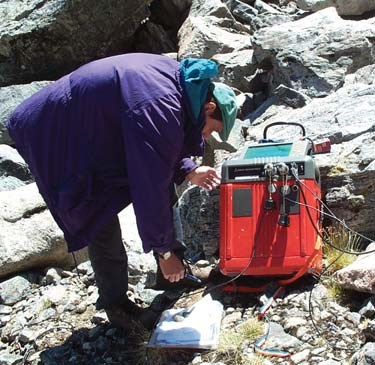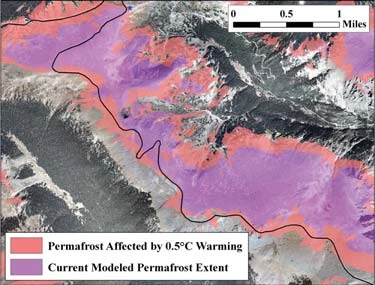Last updated: November 8, 2022
Article
Rock Glacier Response to Climate Change

The Question: How will a change in temperature affect permafrost distribution?
Active and relict rock glaciers in Rocky Mountain National Park provide information regarding previous and current permafrost distribution. Rock glaciers, a mass of angular boulders of various sizes cemented together by ice, are associated with conditions necessary for permafrost to exist. Permafrost, ground that remains at or below 0ºC for at least two consecutive years, is directly aff ected by changes in temperature, such as those predicted to occur as a result of climate change. By determining the extent of rock glaciers a model can be used to predict how present day rock glaciers would respond to an increase or decrease in temperature. If the ice-rich bond of permafrost is removed, slope stability hazards will become more frequent, thus modeling potential change can help anicipate problems.The Project: Examine past and future permafrost distribution using rock glacier topographic variables.
Jason R. Janke of Metropolitan State College of Denver used the extent of rock glaciers in the park and adjoining Indian Peaks Wilderness to examine potential past and future permafrost distribution. Using aerial photographs, previous motion studies, and fi eld investigations, he categorized rock glaciers into three types: 1) Active - moving, contain ice, have a steep front slope, pronounced ridges and furrows, indicate permafrost, 2) Inactive - ceased moving, may still contain ice, have a gentler slope and surface topography, possible permafrost and 3) Fossil - contain no ice, are not moving, vegetated surface, do not indicate permafrost but represent past permafrost distribution. Current permafrost occurrence was based on topoclimatic information (aspect, slope etc.) for rock glacier activity classes. Dr. Janke then calibrated the existing permafrost model using a standard environmental lapse rate for mountains (air cools or warms 0.5° C per 100 m gain or loss in elevation). Using this model, he then predicted how an increase or decrease of up to 4ºC would aff ect permafrost distribution.The Results: If the climate warms as predicted and permafrost declines, the park may have an increase in slope instability as melting ice lubricates slopes.
Relict rock glaciers indicate that Mean Annual Air Temperature (MAAT) was once at least 3.0-4.0°C cooler during the late Pleistocene (over ten thousand years ago) with permafrost extending some 600-700m lower than today. Currently permafrost covers an estimated 12% of the entire study area; while in a 4°C cooler climate permafrost would cover 74%. However, if temperatures were to rise by 4º C, almost no permafrost would be found (<1%). In a 2-2.5°C warmer climate, permafrost would be reduced by 93.9%; given decades to centuries to thaw, no rock glaciers would be considered active. Due to the nonlinear relationship between permafrost distribution and temperature if temperature were to increase by just 0.5º C, approximately 40% by area of permafrost would disappear. It is necessary to keep in mind that the interaction between air and ground temperature is complex, with a signifi cant lag in ground temperature change. Despite this lag (which could be as much as a few hundred years), if global temperatures continue to rise, areas of permafrost will continue to shrink. If the climate warms as predicted, and permafrost declines, the park may have an increase in debris fl ows, rockfalls, slumps under Trail Ridge Road, and other events related to instability as melting ice lubricates slopes. Monitoring changes in the frozen ground will aid in predicting such changes.This summary is based on published, peer-reviewed and/or unpublished reports available at the time of writing. It is not intended as a statement of park policy or as a defi nitive account of research results. For more information on the park’s research program, see www.nps.gov/romo Written by: Diane Escobedo, Geological Society of America Intern Date: August 2007 Updated: January 2008 Photo and graphic credit: Jason Janke

